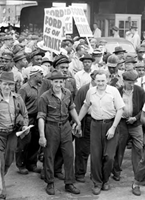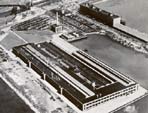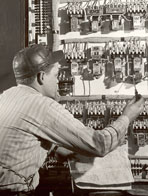
The Degradation of Work Revisited: Workers and Technology in the American Auto Industry, 1900-2000
Labor and the Post-War Automation Movement
During the Second World War, automobile manufacturers engaged in extensive experimentation with new industrial techniques, notably in the area of automated production, often government financed. This initial experimentation later led to the next major technical breakthrough in automobile production—the rise of automated production in the late 1940s and 1950s. Until the post-World War II years, American automobile manufacturers initiated few major technological innovations on the shop floor. To be sure, from the 1920s through the Great Depression, industrial engineers had tinkered and experimented with new methods, new technologies, and new machine designs that would foreshadow the next round of technical change—automation. In the late 1920s, the A. O. Smith Corporation constructed and operated a fully automated auto frame manufacturing plant. Through the 1930s, industrial engineers produced increasingly sophisticated automatic machines. In the war years, the U.S. government funded the experiments for the automated production of artillery shells at the Rockford Arsenal. Automation devices moved the heavy artillery shells from machine to machine, allowing the employment of women in the Rockford Arsenal.In the postwar years, many manufacturers—Ford, General Motors, Dodge and a host of smaller firms—continued to experiment with automation. Nonetheless, the Ford Motor Company was once again in the forefront of the technical innovation of automotive production methods. The investment in automation occurred for varied reasons that ranged from the high cost of unionized labor, the unique Ford union problems arising from the brutal labor relations regime of Harry Bennett, the appearance of aggressive and militant industrial unionism in the huge River Rouge plant, and the fears of a severe labor shortage as a consequence of the Depression-era’s “baby bust” generation. All prompted Ford officials to consider the tantalizing prospect of a considerable reduction of the workforce through automated production.
The militant River Rouge UAW local loomed in the background of eventual Ford decisions to decentralize its operations away from Detroit and to engage in an expensive automation program. This testing of union shop-floor power mainly involved workplace disputes over production standards, shop floor disputes often caused by the introduction of new technologies, machines, or methods. In these production standards conflicts, workers and their supervisors often disagreed about the nature of work, the speed, and the effort required for specific job assignments. In the late 1940s, Ford officials finally insisted on their unilateral right to set production standards. In 1949, the 62,000 River Rouge workers, who then constituted 58% of the Ford workforce, exploded with the twenty-five day speed-up strike. At the time, Robert Asher observed, “Ford tried to force the UAW to accept a virtual ‘unconditional surrender’ of the rights of workers to bargain with management on production standards. It was a major offensive. The UAW counterattacked. Ford lost the battle.”
While Ford officials embarked on their initial exploration of the automation program prior to the speed-up strike, the bitter work standards dispute surely influenced their decision to move forward with the construction of the Buffalo automated stamping plant and later the Cleveland Brook Park engine plants and foundry. Constructed between 1951 and 1953, the Ford Brook Park facility consisted of three separate buildings—two engine plants and a foundry for the manufacture of Ford, and later Mercury, engines. The new Ford facilities, Ford officials reported, “will constitute a highly integrated production operation, with complete interdependence in both scheduling and production.”
Until the Cleveland plant, workers were essential to the actual productive operations in the automotive machine shops. Even in the most technically advanced plants, they were required to move the work from machine to machine. Since operators continued to handle the work, they also managed to control and to pace manufacturing operations. “Despite metalworking’s progress in building and using the high-speed machine and the transfer machine,” the associate editor of American Machinist wrote, “operators still generally handle loading, cycle starting, and unloading. The operator paces output.” In the Brook Park plant, he continued, Ford engineers overcame “the failure to realize the true potential of modern machine tools and metal-removal rates.” In other words, modern machine tools could cut metal faster than workers could load and unload the machines. Consequently, the use of automated methods offered “[i]mportant gains . . . in respect to the number of pieces that can be produced hourly and in savings of direct labor.”
Through the late 1950s and early 1960s as the new automated facilities appeared, an “automation hysteria” gripped the nation and generated fears of mass unemployment. Yet despite such widespread fears and anxieties, these were boom years for the American automobile industry, and production soared to record levels. Moreover, the new production technology fell far short of its promised gains for productivity. Much like the original Ford technical revolution, it proved a bit too rigid and inflexible when it came to design changes for new models. And, flesh and blood humans proved more adaptable than iron and steel machines. Ultimately, after the computer revolution, the most automated production jobs were the dirty and dangerous ones of spray painting and spot welding. In the end, the automobile industry required the unique flexibility of the human mind and human hand, and the legacy of Fordism and degraded work persisted through most of the auto industrial age.
<<Previous Section - Next Section>>
Labor under Mass Production: Ford and the Five Dollar Day
More of the Same: The Rise of Sloanism and Flexible Mass Production
Men at Work? Masculinity and Mass Production in the 1920s and 1930s
The Rise of the Unions and the Effects of World War II
Labor and the Post-War Automation Movement
The “Blue Collar Blues” of the 1970s
About the Project | Credits | Contact Us | Student & Teacher Resources | Site Map
©2004 Automobile in American Life and Society


